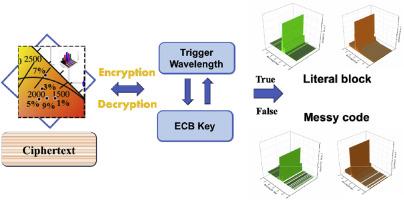Dynamic color encryption controlled by lanthanide dual-mode luminescence emission and logistic mapping
IF 4.2
3区 材料科学
Q2 MATERIALS SCIENCE, MULTIDISCIPLINARY
引用次数: 0
Abstract
Rare earth luminescent materials with broad-wavelength responsiveness are ideal for optical encryption due to their tunable emission properties. When combined with algorithmic assistance, optical information can achieve intelligent feedback and highly secure encryption. In this work, NaYF4 co-doped with y% Eu3+ ions and Er3+ ions is employed to achieve dual-mode luminescence tuning. Under 980 nm and 271 nm laser excitation, switchable orange-red and green luminescence outputs are achieved through electron transition processes. Furthermore, color coordinates are utilized for logistic mapping encryption, where confirmed parameter values generate the desired chaotic behavior, achieving high-capacity and high-complexity multiplexed key streams. The decryption process requires strict adherence to specific readout and iteration rules to access the encrypted information. Additionally, the excitation wavelength is introduced as a checkpoint to trigger decryption. This strategy of coupling logistic mapping with multi-mode luminescence broadens the avenues for efficient optical information encryption, while enhancing both the usability and security of the encryption method.

采用镧系双模发光发射和逻辑映射控制的动态颜色加密
具有宽波长响应性的稀土发光材料由于其可调谐的发射特性而成为光学加密的理想选择。结合算法辅助,可以实现光信息的智能反馈和高度安全的加密。在这项工作中,利用掺有y% Eu3+离子和Er3+离子的NaYF4实现了双模发光调谐。在980 nm和271 nm的激光激发下,通过电子跃迁过程实现可切换的橙红色和绿色发光输出。此外,颜色坐标用于逻辑映射加密,其中确定的参数值产生所需的混沌行为,实现高容量和高复杂性的多路复用密钥流。解密过程需要严格遵守特定的读出和迭代规则来访问加密信息。此外,激发波长被引入作为触发解密的检查点。这种逻辑映射与多模发光耦合的策略拓宽了有效的光学信息加密途径,同时提高了加密方法的可用性和安全性。
本文章由计算机程序翻译,如有差异,请以英文原文为准。
求助全文
约1分钟内获得全文
求助全文
来源期刊

Optical Materials
工程技术-材料科学:综合
CiteScore
6.60
自引率
12.80%
发文量
1265
审稿时长
38 days
期刊介绍:
Optical Materials has an open access mirror journal Optical Materials: X, sharing the same aims and scope, editorial team, submission system and rigorous peer review.
The purpose of Optical Materials is to provide a means of communication and technology transfer between researchers who are interested in materials for potential device applications. The journal publishes original papers and review articles on the design, synthesis, characterisation and applications of optical materials.
OPTICAL MATERIALS focuses on:
• Optical Properties of Material Systems;
• The Materials Aspects of Optical Phenomena;
• The Materials Aspects of Devices and Applications.
Authors can submit separate research elements describing their data to Data in Brief and methods to Methods X.
 求助内容:
求助内容: 应助结果提醒方式:
应助结果提醒方式:


